
MAY CONTAIN NUTS

Search Shorpy
SHORPY ART

Framed or unframed, desk size to sofa size, printed by us in Arizona and Alabama since 2007. Explore now.
Join and Share
Ad-Free Shorpy
Shorpy is funded by you. Patreon contributors get an ad-free experience.
Learn more.

Recent comments
- Roll your own
- Rugged and real!
- A Charles Purcell - Mama Cass Connection
- Uncle SAAM
- Obfuscation
- One Chocolate Soldier rode away
- Victor Marquis de la Roche
- The Little House Across Way ...
- Vanderbilt Gates
- Vanderbilt Mansion
- You can still see that gate
- Withering heights for me
- So Jim,
- Top Heavy
- Re: Can't Place It.
- Bus ID
- Since you mention it
- The White Pages ?
- Moonlight Tower
- 1907?
- Fire(men) and Water
- Can't Place It
- Can anyone
- Wings
- Where's Claudette and Clark?
- Overbuilt Rolodex
- One song
- Give Me Wings Please!
- PRR
- Pinball Wizards
Member Photos
The Shorpy
Printporium
Printporium
Search Shorpy
Search results -- 30 results per page
- Night Moves: 1941
- ... Bogart, George Raft, Ida Lupino and Ann Sheridan.
The railroads got smarter It's true, the boxcars equipped for hauling autos were ... Things were so bad that by the end of the 1950s, the railroads had largely lost the new car trade.
However, by the mid 1960's ... Posted by Dave - 12/04/2018 - 5:19pm -
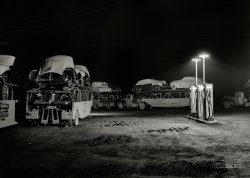
- Railroad Pageant: 1939
- ... shell to PRR K-4 #3768, the engine on the left.
Railroads on Parade
Washington Post, September 24, 1939.
Celeste ... Many Interesting Exhibits.
Don't miss “Railroads on Parade,” the colorful pageant of the iron horses of the past ... Posted by Dave - 03/17/2013 - 4:39pm -
![Railroad Pageant: 1939 May 27, 1939. "New York World's Fair, railroad pageant. Final curtain, locomotives." Large-format negative by Gottscho-Schleisner. View full size.
It does my heart goodMy reaction to this image of locomotives was "Wow!" They look absolutely beautiful. I may just have to put this print on my wish list.
What did one locomotive say to the other?Want to get together and blow off some steam?
End of that eraThe streamliner steam engine on the left represented 1939's top technology, while the old timer on the right recalled the 100-year railroad past at that time. But within 15 years, both engine types would be replaced by first-generation diesels, which still rule the rails today.
Rare ShotThis is the largest photograph I've ever seen of a Lackawanna 4-6-4. I'm guessing she was red trimmed in gold? Would love to see more shots taken that day, particularly if they feature the star of the fair, Pennsylvania Railroad's S-1 duplex type, a one-million pound passenger engine that ran at full speed before the crowd with its drivers positioned on rollers. It had a very similar streamlined shell to PRR K-4 #3768, the engine on the left.
Railroads on Parade
Washington Post, September 24, 1939.
Celeste Weyl.
Transportation Area of World's Fair Offers Visitor Many Interesting Exhibits.
Don't miss “Railroads on Parade,” the colorful pageant of the iron horses of the past and the streamlined engines of today. In 16 scenes and actual settings and costumes of the early days, actors, horses, covered wagons, stage coaches, oxen, mules and locomotives, you see the importance of transportation in the opening of this continent. Starting over 110 years ago, at the New York water-front, in the covered wagon era, the parade of actors, chorus and ballet tells the story of America's conquest of the wilderness.
Below is a fantastic 16mm Kodachrome film of “Railroads on Parade,” by Gustave Martens, posted to YouTube by his grandson. It lacks the Grand Finale but is clearly the same set. Beautiful color.
Looks Can Be DeceivingThe locomotive on the right is actually newer and more modern that the one on the left. The Raymond Loewy styled Pennsylvania 4-6-2 was built in 1920 and streamlined later. The Lackawanna 4-6-4 was built just the previous year in 1938. One visible advancement in the photo, are the cast driving wheels on the Hudson, versus the old spoked drivers on the Pennsy K-4.
A great seriesThis is just part of a great series of photos on the LoC's American Memory Gottscho-Schleisner series. As for the 1939 World's Fair, sadly, idealism and optimism turned into cruel reality with the beginning of World War II. The Polish and Czechoslovak exhibits didn't reopen for 1940, and some Europeans were unable to return home after the fair closed.
World's largest locomotiveThe Lackawanna Hudson here is 1151 and was renumbered "1939" specifically for this fair. In 1940 it was remodeled (with feathers painted on the streamlining) and renumbered "1940". Also designed by Raymond Loewy was the 6-4-4-6 configuration S-1 mentioned by Lost World as running on rollers at the fair. Its speed was a constant 60 mph, all day, and it was the prototype for what the Pennsylvania Railroad intended to replace its fleet of K4 locomotives, which were introduced in 1914. Constructed in the PRR’s Altoona shops (very probably my father, a 38-year PRR employee, worked on it) and completed shortly before the fair, it was the largest locomotive ever built at 304 tons and just over 140 feet long. [OK, second largest. Thank you, Bob100. But it was the longest.] It was too big for most of the Pennsy trackage and less than half of its weight was on its drive wheels, two factors which gave it a very short career. The majestic S-1 was retired in 1945 and scrapped in 1949. Here’s Raymond Loewy and the S-1. Incidentally streamlined outer panels on locomotives did little for performance and got in the way of routine maintenance.
Driving wheelsAlthough they look different, the driving wheels on both locomotives are cast.
Re: World's Largest LocomotiveWhile a very large machine, this one is not quite the largest. That honor would go to the 4-88-4 ALCO Big Boy which ran on the UP. Rated at 6,290 hp, it weighed 548 tons. It was followed closely by the 2-66-6 Allegheny built by the Lima Locomotive Works which generated more horsepower at 7,638 but was 4 tons lighter. The C & O Railroad and the Virginian Railway employed these monsters hauling coal. There are several of both of these locomotives on static display. The third largest, the 4-66-4 ALCO Challenger weighs in at 485 tons and rated at 6,200 hp. It ran on the UP and there is one still active on excursion service.
It makes my heart race just watching videos of these machines pounding along the track. I've been around a few steamers, mostly Shays used in logging, and one thing that has always stood out is the feeling that you are near a living being. Listen closely to the sounds associated with steam engines, especially a locomotive. It's like you can hear it breathe. No wonder that so many crewmen grew attached to their machine. Each one had its own peculiar sounds due to pop valve configurations, expansion and contraction, exhaust valves, whistle, &c. Probably the nearest any manmade machine will ever come to being lifelike.
(The Gallery, Gottscho-Schleisner, NYC, Railroads)](https://www.shorpy.com/files/images/SHORPY_5a16875u.thumbnail.jpg)
- Westbound Freight: 1943
- ... Office? Jack Delano seemed to specialize in photo's of railroads (and this one in particular) during WWII. But why?
Historic ... from natural gas drilled in Texas.
Why Photograph Railroads WWII honed logistics to a science. We had never fought a war of ... Posted by Dave - 09/05/2012 - 6:08pm -
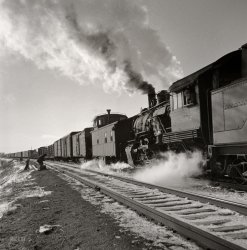
- Defect Detective: 1943
- ... and the green flags denote another section following.
Railroads when they were interesting.
Still Run BNSF still runs these on ... today The trend for a long time has been for the major railroads to sub out all the work they can, and most of this sort of defect ... Posted by Dave - 10/06/2024 - 3:59pm -

- Levee Work: 1903
- ...
R.R.s Can anyone identify the A&V and S.I.C.V. railroads?
Reporting Mark I've only been able to find the A&V which ...
Thanks for showing us a long-gone New Orleans.
The railroads are the Alabama & Vicksburg, which ran between Meridian and ... Posted by Dave - 07/19/2012 - 4:35pm -
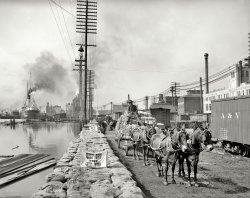
- Section Gang: 1943
- ... Mercer.
(The Gallery, Jack Delano, Native Americans, Railroads) ... Posted by Dave - 09/30/2024 - 12:52pm -
![Section Gang: 1943 March 1943. "Cajon, California. Indian section gang working on the Atchison, Topeka and Santa Fe Railroad track." Photo by Jack Delano, Office of War Information. View full size.
Pursed lipsProve that rail is definitely heavy.
How many do they need?Good a guess as any: the 39-foot rail weighs 112 pounds per yard, so say 1,500 pounds total with the tongs. What do they have, 16 guys carrying it? But no doubt they try to manage with fewer, now and then anyway.
What tribe? Which rail location?I'm reading Tony and Anne Hillerman novels, set in New Mexico, and each tribe can instantly recognize another's heritage, Navajo or Hopi or Pueblo, etc. What tribe might these be, and what part of the country?
[Read. The. Caption. - Dave]
[I. Did. Dave.] What tribe was my wondering.
Somethings not rightI agree - it looks staged for the photo. The front group of men are taking a step while the rear group don't even appear to have their end of the rail off the ground yet (or just barely). Facial expressions on the lead men looks like they're just about to break out laughing.
I don't like the look of that supervisorHe's wearing what my generation knew as a drill-sergeant's hat. An appropriate association, because railroad section gangs, typically minorities or immigrants, and sometimes convicts, were subject to harsh discipline.
Section gangs were also called 'gandy dancers', the 'gandy' being a five-foot iron lever used to align track as the crew moved forward. All the gangs used chants or songs to coordinate movement. But the term 'gandy dancers' has become specifically associated with southern Black crews whose moves achieved balletic coordination. The original of folklore legend John Henry may have been a gandy dancer.
Heavy!That section of rail probably weighed about 68 pounds per foot. No wonder it took a lot of men to carry it.
Straining or laughing?I see some guys trying not to laugh while they are participating in a staged shot.
[This is not in any way "staged." - Dave]
@louJudsonYou'll learn not to ask questions, lest you run afoul of Mr. Pedantic.
The real "Gandy"There was a famous shovel manufacturer, The Gandy Company. Hence, the Gandy dancer track worker waltzing with his shovel all day.
Their catalog contained many two-hand tools designed for railroad trackwork.
On the ground, we see two such items: a large track bolt wrench and a spike puller. To the men doing the work, the spike puller was known as a "Roadmaster." One can only speculate if that was because the track foreman's boss, the Roadmaster, was only able to perform one job (i.e. harassing the track foreman) or because it was such an unbalanced tool (i.e. like the roadmaster's mental state)
The men doing the lifting or the curve-worn section of rail (notice the worn away head on the left side of the rail) are using rail tongs, possibly a Gandy product but just as likely to be from Buda, Fairmont or a dozen other makers.
No Mel Brooks fans?!?I came here to see the Blazing Saddles quotes!
Cheap laborThey could have used a four hunnert dollar handcart to roll those rails down the line.
What Tribe? Huh?The principal AT&SF RR ran from Los Angeles to Chicago, with many branches. Just because the workers are photographed near Cajon doesn't mean they lived in the area. They could have come from anywhere in the country. Just for reference, the following tribal nations reside in San Diego County: Kumeyaay, Luiseno, Cupeno, and Cahuilla.
Not Too Long a Long WalkThe laborers are not carrying that rail any great distance. Based on the presence of a spike puller and track wrenches laying just to the left, repairs are underway in the immediate area. The worker on the right is carrying a spike maul and so is probably not the foreman - I'd guess it is the man with the white hat to the rear.
How do you stop slackers?One wonders how the foremen detected and dealt with the slacker(s) who would do a little less lifting than his comrades.
Working all the live long dayLaying track to Rock Ridge and keeping rhythm to a Cole Porter work song.
The theme song"On the Atchison, Topeka and the Santa Fe" was written by Harry Warren and Johnny Mercer.
(The Gallery, Jack Delano, Native Americans, Railroads)](https://www.shorpy.com/files/images/SHIORPY-8d45055u.thumbnail.jpg)
- Clinton: 1943
- ... on the left and still exists today.
Two depots, three railroads The Chicago & Northwestern passenger depot is the large ... Town
Many photos and info about the depots and railroads that served Clinton.
(The Gallery, Jack Delano, Railroads) ... Posted by Dave - 10/26/2016 - 5:17pm -
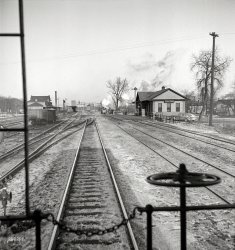
- Jacobs Transfer: 1943
- ... (The Gallery, Baltimore, Cars, Trucks, Buses, John Vachon, Railroads) ... Posted by Dave - 10/05/2024 - 8:23pm -

- ATSF 5006: 1943
- ... to the wheel arrangement!
(The Gallery, Jack Delano, Railroads) ... Posted by Dave - 10/07/2024 - 11:21am -
![ATSF 5006: 1943 March 1943. "Vaughn, New Mexico. One of the 5000 Class Atchison, Topeka and Santa Fe Railroad freight locomotives about to leave on the run to Clovis, New Mexico." Medium format acetate negative by Jack Delano for the Office of War Information. View full size.
Someone fed Jack some bad info.There was only one 5000 Class (Locobase 457) ATSF steam locomotive, road number 5000, known as Madame Queen.
ATSF 5006 was actually a Texas Class 5001 (Locobase 458) locomotive, and the first oil burner in the series of 10 (road numbers 5001-5010). Some sources say this class developed the highest piston thrust ever recorded, 219,000 lb.
[Back when they were new, these engines were referred to as both 5000-class and 5001-class, if numerous newspaper accounts are any guide. The article below details the wreck of ATSF 5004, a "giant 5000 class locomotive." - Dave]
A Beautiful MachineI've seen plenty of steam locomotive pictures over the years, and appreciate pretty much all of them. But every once in a while there's a photo that really sums up the power and poetry of steam engineering. A massive machine designed with a single purpose in mind, where every individual component has a utilitarian form and reason, and whatever "styling" the whole has is dictated purely by function and a century of experience and refinement. It's a beautiful beast.
Also, props to the Shorpy logo for paying tribute to the wheel arrangement!
(The Gallery, Jack Delano, Railroads)](https://www.shorpy.com/files/images/SHORPY-8d15447a.thumbnail.jpg)
- Santa Fe Four: 1943
- ... hauling coal a long ways.
(The Gallery, Jack Delano, Railroads) ... Posted by Dave - 09/24/2024 - 11:24am -
![Santa Fe Four: 1943 March 1943. "Wellington, Kansas. An Atchison, Topeka and Santa Fe Railroad crew posing in front of their engine before pulling out of Wellington for Waynoka, Oklahoma. Left to right: D.C. Quivey, head brakeman; D.B. Wallingford, conductor; B.F. Hale, engineer; and fireman Walker." Acetate negative by Jack Delano for the Office of War Information. View full size.
A couple of Stormy KromersWith a lot of miles on them I'll bet.
Brakeman?The fellow on the far left is carrying a shovel. I'd wager he's the fireman, and the brakeman is on your far right.
[That's a glove, not a shovel. Stoking locomotives with shovels ended long before this photo was made. - Dave]
StatusDelano signaled the relative job status of each man: conductor and engineer in the middle, head brakeman with adjective of rank (a standard crew would have had a second brakeman), fireman without initials (unless Walker was his first name, in which case even more so). Even their heights convey comparative 'stature'.
Dress CodeSeems like a necktie is a bit overdressed to be shoveling coal into a firebox. Or any other job on a steam engine like this one.
Not just oneBut two cardigans on Mr. Wallingford.
UnfunIn my childhood musings, I thought driving a locomotive would be a blast, but these guys don't look like they have any fun at all!
JokeQ: Why can't a steam locomotive sit down?
A: It has a tender behind!
The Un-CoalerOh, look! The single-named fireman has a 'shovel' under his arm too! Seriously, ol' #4097 didn't need any shoveling in any event since she was an oil burner. Makes sense in Texas and similar instead of hauling coal a long ways.
(The Gallery, Jack Delano, Railroads)](https://www.shorpy.com/files/images/SHORPY-8d15277u.thumbnail.jpg)
- Owego: 1901
- ... Most of the building shown are still there.
Owego Railroads The tracks very visible in this view were of the Delaware, ... in this picture.
(The Gallery, Boats & Bridges, DPC, Railroads, Small Towns) ... Posted by Dave - 11/28/2022 - 10:39pm -
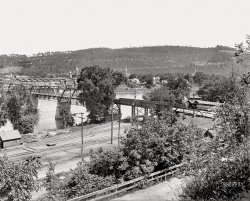
- Grand Central Terminal: 1913
- ... through rail traffic.
(The Gallery, G.G. Bain, NYC, Railroads, Streetcars) ... Posted by Dave - 09/10/2024 - 5:21pm -
![Grand Central Terminal: 1913 New York's Grand Central Terminal nearing completion sometime around 1913. 8x10 glass negative, George Grantham Bain Collection. View full size.
Grand centralthe sky is so clear...
Strange perspectiveThe building looks like it will tumble to the right and at the same time to the front. Very strange!
The corner entranceI walked through that exact entrance countless times when I was in my 20s (in the 80s). It's wild to see it as it was in 1913 and to contemplate the untold millions who preceded me and those who have come after me.
City GrowthJeeze, it is incredible to see it as it was!
So many new buildings now clutter and overshadow that scene.
I wish we could get a current pic at that same angle, and compare our "progress".
Grand CentralHere's how that entrance looks today.
Shorpy is a wonderful site--I read it every day. Keep up the great work!
Grand Central StationActually there is also a Grand Central Station that has nothing to do with the Post Office - it's a former IRT transfer point that also serves the Terminal building.
I suspect that while the use of the term Grand Central Station was common in New York for a long time, it really became common usage because of the radio program of the 1930s or '40s by that name.
Grand Central TERMINALGrand Central Station is a POST OFFICE! This is Grand Central TERMINAL! It sez so on the building itself right below the clock, IIRC.
[cc: G.G.B. - Dave]
Third (and fourth) railsThere appear to be two buried "third rails" on the streetcar track (contacted by a plow), and on one of the two tracks, the third rails cross and trade places. Maybe some New York trolley fan could explain this strange arrangement.
Third and Fourth RailsTwo different streetcar companies shared the track on 42nd Street between Madison and Park Avenues (where this photo was taken), they each had their own conduit rail to power only their own cars.
Source: "Manhattan's Lost Streetcars"; Images of Rail (2005); page 31
GCTThe facility is the end of the rail line; hence the name Grand Central Terminal. Pennsylvania Station is named as such since it provides for through rail traffic.
(The Gallery, G.G. Bain, NYC, Railroads, Streetcars)](https://www.shorpy.com/files/images/01835u3.thumbnail.jpg)
- Westbound: 1943
- ... I could unmute photographs.
(The Gallery, Jack Delano, Railroads) ... Posted by Dave - 09/23/2024 - 11:55am -
![Westbound: 1943 March 1943. "A westbound Atchison, Topeka and Santa Fe passenger train passing by a siding near the town of Hoover, Texas, enroute to Amarillo." Acetate negative by Jack Delano for the Office of War Information. View full size.
OklahomaSignal 4202 means they're in Oklahoma, a few miles southwest of Shattuck. The engines just crossed above the east-west county road at 36.202N 99.9312W.
Two passenger trains a day were scheduled Chicago to LA via Amarillo; the Grand Canyon was due out of Shattuck at 8:50 AM Central War Time.
Dos LocosSeems odd to have two heavy locomotives on such a short train.
Double HeaderBeautiful photo! If you enlarge the photo enough, you’ll see the second engine, the fireman hanging out of the cab, and the semaphore on the other side of the track.
¿Por qué dos locos?Probably because of all those mountain grades they have to cross.
[The Texas Tetons? - Dave]
I WishThat I could unmute photographs.
(The Gallery, Jack Delano, Railroads)](https://www.shorpy.com/files/images/SHORPY-8d15319u.thumbnail.jpg)
- R.R. D.J.: 1943
- ... Bunn Special, but many companies made them for the railroads to specifications.
Button It Up Ah, the pants of my youth: ... monitor.
(Technology, The Gallery, Jack Delano, Railroads) ... Posted by Dave - 09/18/2024 - 12:34pm -

- Toledo: 1909
- ... Publishing Company. View full size.
Long gone railroads These railroads are so long-gone, that the companies that took these over are also ... Posted by Dave - 10/22/2011 - 7:24am -
![Toledo: 1909 Toledo, Ohio, circa 1909. "Maumee River waterfront." 8x10 inch dry plate glass negative, Detroit Publishing Company. View full size.
Long gone railroadsThese railroads are so long-gone, that the companies that took these over are also long-gone.
Hocking Valley Ry became part of Chesapeake and Ohio, which is in turn part of today's CSX Transportation.
Toledo and Ohio Central and Kanawha and Michigan were both absorbed by New York Central System. NYC as part of Conrail, was split up between Norfolk Southern and CSX Trans.
Hocking Valley, Kanawha and Michigan and Toledo & Ohio Centraland ... lots of Hocking Valley Railway, Kanawha and Michigan Railroad and Toledo and Ohio Central Railroad train cars to be seen.
Toledo? You ask how I know of Toledo, Ohio,
Well, I spent a week there, one day
They've got entertainment to dazzle your eyes
Go visit the bakery and watch the buns rise.
Code BreakerI wonder if all transmissions aboard the Jay C. Morse are done in code.
Spotted over above right, a roof hoarding advertising the Snow Flake Laundry, what a great name, hopefully not too indicitive of the weather patterns in Toledo.
Jay C. MorseThe ore freighter is named for the industrialist co-founder of one of the era's most powerful steel and mining companies (Pickands, Mather & Co.). In 1899, at age sixty, Jay Morse married Seville Hanna, the widow of his business partner James Pickands and sister of the sitting president's "Karl Rove," Mark Hanna. Morse died August 22, 1906, and on July 21, 1907 his widow helped to launch the steamship bearing his name.
Is it live, or is it Memorex?Please excuse the audio reference to obviously visual dilemma.
This looks like the most awesome HO train setting I've ever seen!
SS. Jay C. Morse Photographed here in her first year on the lakes, the Jay C. Morse, AmShip Cleveland hull #438, was in service for over seven decades. After a final few years as a lowly storage barge, she was scrapped in the 1980s. Her wheelhouse, removed prior to commitment to the scrapyard, was saved and made into a maritime museum in her last port, Goderich, Ontario. Comparison of the the 1908 photograph with the preserved wheelhouse/museum indicate either substantial rebuilding of the bridge or complete replacement during some mid-life refit.
Boatnerd.com has a 1980 photo of her during her final years as a grain storage barge.
The Scanner, Toronto Marine Historical Society, 1978.
The bulk carrier Jay C. Morse which was acquired early in the spring of 1965 from the Interlake Steamship Company and renamed Shelter Bay (II). After operating Shelter Bay for the 1965 season, Q & O [Quebec And Ontario Transportation Co.] decided that the ship was in need of reboilering. It was not thought that the cost of new boilers for such an elderly vessel could be justified and so Q & O searched for some good used boilers which might be obtained at a more reasonable price. The company did not have far to look and decided to purchase from Marine Salvage Ltd. the boilers which were then ensconced in Bayton.
In due course, workmen went aboard Bayton and commenced pulling apart the old girl's after cabin. Her stack removed and a hole chopped down through her upper decks, the Babcock and Wilcox water tube boilers were lifted from the vessel and were carted 'round to the West Street Wharf in Port Colborne where Shelter Bay was lying. During the summer of 1966, the boilers were installed in Shelter Bay and she has operated with them ever since. Q & O, however, might better have searched elsewhere for boilers rather than taking third-hand equipment for the conversion. In recent years, Shelter Bay has been plagued with boiler problems and a particularly nasty spate of difficulties during 1977 threatened to send the boat to the scrapyard. She was reactivated in 1978 for one further year of operation but continued struggles to keep the well-worn boilers in serviceable condition are almost certain to bring the ship to the end of her career at the close of the current navigation season.
The Scanner, Toronto Marine Historical Society, 1979.
The latter steamer [Shelter Bay (II)] went to Goderich last autumn with storage grain and was sold to the Goderich Elevator and Transit Company Ltd. for use as a storage barge. She was briefly renamed Shelter B. (perhaps unofficially) but has since been rechristened D.B. Weldon (II).
The Lightship, Port Huron Museum, 1999.
[Shelter Bay of Q & O] would become the D.B. Weldon (2) and, in 1981, her forward cabins and wheelhouse would be removed to become the Maritime Museum now in display at the harbor [Goderich, Ontario].
(The Gallery, Boats & Bridges, DPC, Railroads, Toledo)](https://www.shorpy.com/files/images/4a19192a.thumbnail.jpg)
- Skyline: 1943
- ... think of Texas.
(The Gallery, Jack Delano, Landscapes, Railroads) ... Posted by Dave - 09/22/2024 - 4:41pm -

- Grand Central: 1900
- ... over these tracks.
(The Gallery, DPC, Horses, NYC, Railroads, Streetcars) ... Posted by Dave - 09/10/2024 - 3:21pm -
![Grand Central: 1900 New York circa 1900. "Grand Central Station and Hotel Manhattan." The coming decade would see the replacement of this structure by the current Grand Central Terminal. 8x10 inch glass negative, Detroit Photographic Company. View full size.
The eagles of Grand CentralA search for Grand Central Eagles yields interesting stories.
The couple who found one in their back yard.
And the story of one that ended up Upstate.
Poor Grand Central Station only lasted 12 years: from 1898 to 1910.
Electric TrolleyIt's surprising to see electric trolleys and horse-drawn trolleys sharing the same set of tracks, but also surprising to see an electric trolley with no overhead wires -- how did it pick up the electricity?
[Through the slot between the rails. - Dave]
A streetcar named electricThe last of Manhattan's cable cars were converted to electric power around 1901. The car draws its current via a "shoe" that extends down through the slot seen running between the tracks. Same system used by electric streetcars in Washington, D.C., many examples of which can be seen on these pages:
Cable car?I'd be pretty confident saying this is a "cable car." The Metropolitan Street Railway operated cable trolleys.
http://www.cable-car-guy.com/html/ccnynj.html#msry
San Francisco wasn't the only place that had them.
[In 1898 the Metropolitan Street Railway began converting its cable traction lines to underground electric power. - Dave]
Eagle on the ballIt is speculated the that eagle below the dome ended up in Essex, NJ at the Space Farms Zoo and Museum.
http://outdoors.webshots.com/photo/1113715013034126691DiLhTm
Greg
American ExpressWikipedia tells me AmEx started as an express mail and shipping operation. What do you think this wagon's delivering, and to whom?
White Wing!The man lower right in the white suit and pith helmet is a "White Wing." These were the first street cleaners in New York.
Lone HorsemanThis is the first urban horse & carriage era Shorpy picture in which I recall seeing a (civilian) man on horseback, rather than drawn in a wagon or carriage (he's right above the streetcar). Maybe I wasn't paying enough attention, though!!
I wonder if he ever took his horse up to Central Park for a lively canter.
Broncs to BikesUrban horseback riders at the turn of the last century were regarded in a similar way to how we view motorcyclists today; traveling light, moving fast, a bit intimidating (ex: mounted police), a little daredevilish & somehow just a touch less civilized. I mean, you never see the very Edwardian Sherlock Holmes mount a horse except in an emergency.
In many ways, today's bikers have adopted the horseman's accoutrements and lingo: leather chaps, buckskin and fringe, saddles and saddlebags, triple-trees, trick riding, trail runs, etc.
"I'm a Cowboy, on a Steel Horse I Ride!" - Bon (yech) Jovi
Sharing the tracksIn the lower right, under the American Express horse, are the remains of the railroad tracks crossing the horse car track. They joined the trolley track on Fourth Avenue or Park Avenue South, as shown in other Shorpy photos. Even after the 1st Grand Central was built about 1873 and steam locomotives were banned from the streets of lower Manhattan, the New York, New Haven & Hartford RR still insisted on using horses to pull its passenger cars farther downtown over these tracks.
(The Gallery, DPC, Horses, NYC, Railroads, Streetcars)](https://www.shorpy.com/files/images/4a07322a.thumbnail.jpg)
- Hydration Station: 1943
- ... Southern Pacific used.
(The Gallery, Jack Delano, Railroads) ... Posted by Dave - 09/15/2024 - 5:30pm -

- Elko County: 1940
- ... Security Administration. View full size.
Three railroads In this shot looking northwest from the US 93 overpass, the tracks ... the 1990s.
(The Gallery, Arthur Rothstein, Landscapes, Railroads) ... Posted by Dave - 01/30/2018 - 9:58am -
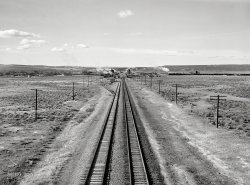
- Hammer and Tongs: 1943
- ... carried a pair of prime movers on a single long frame. Railroads liked the concept, but the new, bigger and heavier 567 prime mover ... as one with drawbars (A-A, A-B-A or A-B-B-A) allowed the railroads to circumvent this. And on many railroads, these multi-unit sets all ... Posted by Dave - 07/29/2024 - 9:58pm -
![Hammer and Tongs: 1943 March 1943. "Santa Fe R.R. shops, Albuquerque. Hammering out a drawbar on the steam drop hammer in the blacksmith shop." 4x5 Kodachrome transparency by Jack Delano for the Office of War Information. View full size.
Drawbar 101Drawbars formed a quasi-permanent connecting link between a steam locomotive and its tender. It needed to be physically robust and have exceptionally high tensile (stretching) strength, since it would bear the entire starting/rolling load of a train weighing several thousand tons. The "hammering" you see in the photo was part of the forging process that imbued the drawbar with its strength. Early diesel locomotives experimented with drawbars, but since diesels carried their own fuel, drawbars created an unnecessary limitation to mixing and matching locomotives and were quickly abandoned as a relic of the steam age.
One sturdy chainI admittedly know nothing about metal working but I'm a bit surprised that the big orange glowing bar isn't melting that chain.
The ChainPretty basic explanation about the chain - if the temperature isn't hot enough to melt the steel drawbar it wouldn't be hot enough to melt the steel chain. In hot working like this, the lower limit in terms of temperature is 2000 degrees Fahrenheit. Melting point of steel varies by the alloy, but it often melts at 2500 degrees Fahrenheit.
Diesels & DrawbarsActually it wasn't an experiment. Diesels were connected by drawbars for several reasons.
EMD had considerable success with its prewar E units, which carried a pair of prime movers on a single long frame. Railroads liked the concept, but the new, bigger and heavier 567 prime mover designed for the F series freight diesels made this impossible. EMD solved this with the cabless booster, or B unit, which was connected to a standard A unit with a cab. An A-B set is really one locomotive with two prime movers, albeit not under the same body.
Union rules at the time required that each locomotive have an engineer and fireman. So if you wanted to run an A-B + B-A or A+A set of new diesels, you paid two crews. Connecting two, three or four units as one with drawbars (A-A, A-B-A or A-B-B-A) allowed the railroads to circumvent this. And on many railroads, these multi-unit sets all carried the same number, but each had a different letter, such as 1091A, 1091B etc. for the same reason.
The biggest headache was maintenance – if one unit went down, all had to be taken out of service. As diesels took over, the old rules were finally abandoned, and F units were fitted with standard knuckle couplers so they could be mixed and matched as needed.
Diesels & Drawbars & Santa FeI don't disagree with the discussion on drawbars on diesels, however the shops in Albuquerque were Santa Fe, one of the first railroads to reject the concept of fixed consists in favor of couplers on all units. According to most of the normal sources (McCall's "Early Diesel Daze", for example), this started with the very first road freight locomotive they purchased, FT 100.
It looks to me like they've only just started forging whatever they're making and it's a little too early to say what it's going to be. It could very easily be a side rod or main rod for a steam locomotive.
[We think it's a drawbar because it says so in the caption -- which was written by Jack Delano, who took the picture. - Dave]
The bar and the chain are both steel.It is certainly possible for the work to head up the chain to glowing, but seeing as both of them are the same material it is impossible for it to melt the chain.
Also they are turning the bar ninety degrees between passes to draw it out square. (Drawing round under flat dies is a bad idea.) Turning the bar brings a different section of the chain in contact with the hot bar. Also the area of contact between the chain and the work is fairly small so the transfer of heat would be slow.
More Santa Fe railroad shop picturesHere are some additional pictures of the Santa Fe railroad shops, including several shots of that very same steam hammer and the nearby forge. Other pictures in the series confirm that it is indeed a drawbar being forged. The temperature of steel at orange-yellow is about 1800F. The melting point of steel is around 2500F, depending on the alloy.
DANGEROUS WorkThis was Dangerous work, with a capital D.
Nothing like blunt, super-heavy red hot machinery to put human vulnerability into sharp relief. When I see a picture like this I feel a surge of patriotism, despite my cynical metro-self. Dang it, there was a time in this country that when we needed something made or built, we made or built it, right there and then.
[What country is the planet's current No. 1 producer of manufactured goods? It is still the U.S. of A. - Dave]
(The Gallery, Kodachromes, Albuquerque, Jack Delano, Railroads)](https://www.shorpy.com/files/images/1a34730u.thumbnail.jpg)
- Boxcar Builders: 1943
- ... closed car and was bulky.
(The Gallery, Jack Delano, Railroads) ... Posted by Dave - 09/17/2024 - 10:29am -

- Over the River: 1902
- ... account of Kate on the net as well.
Boone-area railroads Boone and Scenic Valley (with their Chinese-built steam loco) ... a stereoview of this somewhere...
(The Gallery, DPC, Railroads, W.H. Jackson) ... Posted by Dave - 08/03/2012 - 3:04pm -
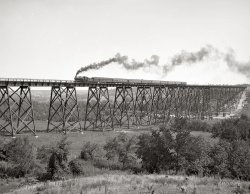
- One Second Fast: 1943
- ... Fast Accurate timekeeping was extremely important to railroads back in the day. Timepieces would be tested once a year, primarily ... alphabetic operation.
Standard time It's because of railroads that we have time zones. Can you imagine trying to arrange a railway ... Posted by Dave - 07/29/2024 - 9:58pm -
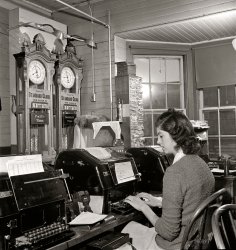
- Super Chief: 1943
- ... that is no longer owned by Santa Fe successor, BNSF. That railroads still fuels its transcontinental trains in nearby Belen, NM.
... !
(The Gallery, Kodachromes, Albuquerque, Jack Delano, Railroads) ... Posted by Dave - 07/29/2024 - 9:58pm -
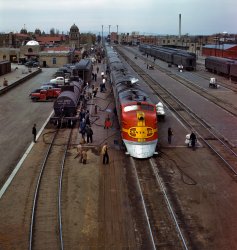
- Manda: 1905
- ... water.
(The Gallery, Boats & Bridges, Cleveland, DPC, Railroads) ... Posted by Dave - 09/08/2024 - 3:50pm -

- Public Square: 1900
- ... replaced the horsecars on its line in 1893.
Western Railroads TerryN, thanks for pointing out the CM&StP sign in the window. ... Rock Island. The interesting thing is that none of these railroads served Cleveland, at least not directly. They all went from Chicago ... Posted by Dave - 04/07/2023 - 11:19am -
![Public Square: 1900 Circa 1900. "City Square. Soldiers' and Sailors' Monument, Cleveland." 8x10 inch dry plate glass negative, Detroit Photographic Company. View full size.
The May Co. BuildingWow, looks like the predecessor of the modern curtain-wall design. Large lights of 1/4" plate glass no doubt. Would love to see some architectural drawings of that facade.
Chicago Milwaukee & St. Paul Soon to become The Milwaukee Road, with Hiawatha service to almost anywhere. Brook Stevens who designed their rail cars would have (maybe did) marveled at the May Co. building of the future.
I'm marveling at in this picture. Probably 50 years before its time.
No rebellious women?One would think there would have been at least one daring young woman who would have had the gumption to wear a black blouse with a light colored skirt, just to be a little outrageous and stand out, but nooooo. Times sure have changed in the area of seeking attention through outrageous fashion and personal appearance. Or maybe today's girls just feel more comfortable expressing themselves, which certainly does make street scenes more interesting.
Where's the Cable Car?http://www.cable-car-guy.com/html/ccohio.html#cccr
According to the above link, the cable car slots under the trolley car were used for another year until 1901, even thought the St. Clair trolley car in the foreground had directly replaced the horsecars on its line in 1893.
Western RailroadsTerryN, thanks for pointing out the CM&StP sign in the window. The same building also has signs for the Burlington Route and Rock Island. The interesting thing is that none of these railroads served Cleveland, at least not directly. They all went from Chicago westward. So their offices in Cleveland must have been for exchange of freight between eastern and western railroads, I suppose.
Euclid BeachA year later, the Humphrey family would take over Euclid Beach Park east of the city, and turn it into a legend.
You can still buy their popcorn at many stores in NE Ohio.
The Edison patented lightbulb goes onAfter seeing so many flagless giant flagpoles on major buildings here on Shorpy, it finally dawned on me that they were not intended for a US flag, but for advertising/corporate ID, as can be seen here.
Inside the Monument?It appears that there is a door leading into the monument itself. Does anyone know what this leads to and is the interior still accessible? Secret enterance to the Great Lakes Brewing Company tasting room perhaps?
[What's inside the Civil War monument is addressed in the comments here. - Dave]
May Co. reduxHere's a later view of the May Co. building, greatly expanded.
One has to wonder if this postcard is again the work of Detroit Publishing.
The gardensI like the surrounding gardens that have been made into the shapes of Unit or Division emblems and heroism awards.
(The Gallery, Cleveland, DPC, Streetcars)](https://www.shorpy.com/files/images/4a08340a.thumbnail.jpg)
- Dragon Garage: 1943
- ... made from old boiler tubes.
(The Gallery, Jack Delano, Railroads) ... Posted by Dave - 09/17/2024 - 8:25pm -

- Sideways: 1943
- ... side observations The two flats were owned by small railroads, the Detroit, Toledo & Ironton and the Florida East Coast. In the ... bridge.
(The Gallery, Arthur Siegel, Detroit Photos, Railroads) ... Posted by Dave - 08/20/2024 - 12:21pm -

- Passenger Portal: 1911
- ...
(The Gallery, Chicago, DPC, Railroads) ... Posted by Dave - 09/03/2024 - 4:13pm -
![Passenger Portal: 1911 Chicago circa 1911. "Passenger terminal, Madison Street entrance, Chicago & North Western Railway." 8x10 inch dry plate glass negative, Detroit Publishing Company. View full size.
500 West Madison StreetThis terminal occupied the north side of West Madison, between Canal and Clinton, until 1984, when it was razed and replaced by the 42-story Citicorp Center (now Accenture Tower). But the station survives as the Ogilvie Transportation Center.
The terminal was new when this 1911 photo was taken. It was designed by the Chicago firm of Frost and Granger, both talented architects who designed multiple stations for their mutual father-in-law, the president of the very successful Chicago & North Western Railway.
Knowing TimeMy grandfather always said that the only person that can tell the correct time is the person with only one timepiece.
Railroad Time(s)Is it 1:50 or 1:51?
Combine Norma Desmond with Ingrid Bergmanand you'll get a gaslight that's ready for its closeup. Tho by no means a novelty in this time period - the last gas street lamps in Chicago weren't extinguished until 1954 (!!) - they were nonetheless becoming unusual. But how many looked like this? With an elaborate - and seemingly unnecessary - hood. Or maybe it's something else entirely: can anyone ... uhm ... shed a little light on the matter?
[That's a carbon arc (electric) streetlight, not gas. - Dave]
I'll buy that - joke ruining as it may be - but what a weird and fussy design! The last one to be outed here on Shorpy looked quite different.
(The Gallery, Chicago, DPC, Railroads)](https://www.shorpy.com/files/images/SHORPY-4a24207a.thumbnail.jpg)
- Grand Central: 1900
- ... "coming soon" for 100+ years.
(The Gallery, DPC, NYC, Railroads, Streetcars, W.H. Jackson) ... Posted by Dave - 09/10/2024 - 8:34pm -
![Grand Central: 1900 New York circa 1900. "Grand Central Station, E. 42nd Street and Vanderbilt Avenue." 8x10 inch glass negative by William Henry Jackson, Detroit Photographic Company. View full size.
Thank you, Cornelius VanderbiltHere is a well written history of Grand Central Depot/Station/Terminal. It includes a photograph very similar to this one. Cornelius Vanderbilt was ruthless in his drive to be ever richer. But we wouldn't have Grand Central today if it weren't for him.
Grand Central TerminalGrand Central is a terminal, not a station.
[Grand Central Terminal opened in 1913. Before that, there was Grand Central Station. Which was an enlarged version of Grand Central Depot. - Dave]
Yup. I forgot to look at the year of the photo. ;-)
You Say Station, I Say Potato ...This may seen needlessly pedantic, but we all have our pet peeves ...
A terminal is the end of the line; a station passes traffic, and a depot is a place where goods or equipment are unloaded and stored. The term "passenger depot" gets thrown around, I know, but a depot is supposed to indicate the use of the tracks and sidings, and may be part of a terminal or a station. The term passenger depot was uncouth because it implied that passengers were no different than coal or cattle (insert joke here).
The railway right of way up Park Avenue dates back to 1832, and the tracks that became the NY Central originated on the Bowery somewhere and went north into Harlem. A structure built at 42nd Street before 1854, when steam locomotives were outlawed below 42nd Street, would have been a station (and also perhaps a depot). When the 1869-1871 "Depot" building in the link above was built, I believe that service still extended southward to at least 14th Street pulled by horses, but I could be wrong. When the current GC Terminal was built in 1913, however, it was truly a terminal.
There is still a Grand Central Station, however! It's below the Terminal, and part of the NYC Subway system. The mosaics on the 4/5/6 line are suitably ambiguous, but the MTA's signs respected the distinction.
New serviceLong Island Rail Road trains can now use Grand Central as the result of a project known as East Side Access. It was supposed to be completed in 2009 at a cost of $3.5 billion. It opened in early 2023 at a cost of $11 billion. Still, that's better than the Second Avenue Subway, "coming soon" for 100+ years.
(The Gallery, DPC, NYC, Railroads, Streetcars, W.H. Jackson)](https://www.shorpy.com/files/images/SHORPY-4a08820a.thumbnail.jpg)























